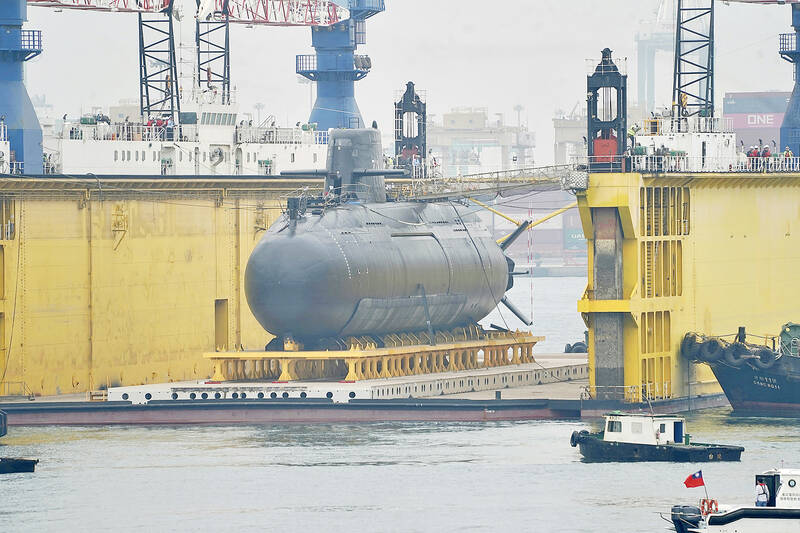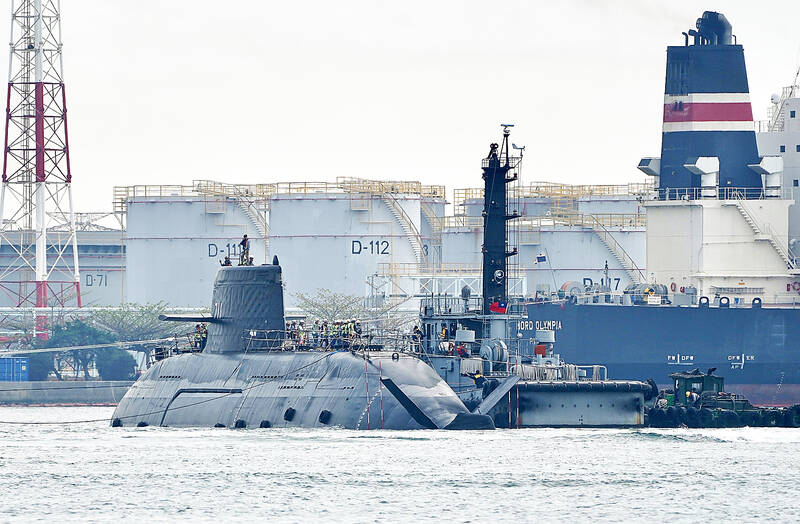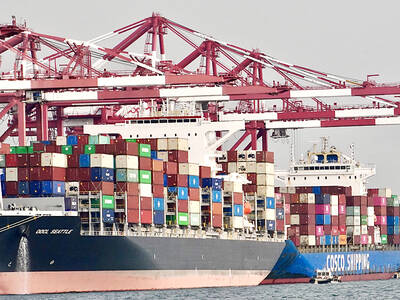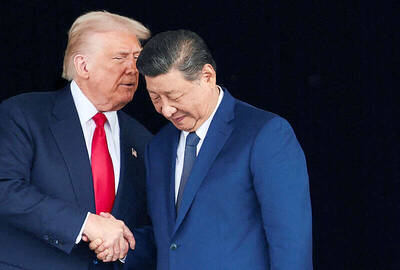The nation’s first domestically built submarine prototype, the Hai Kun (海鯤號), yesterday was transferred to a dry dock for final harbor acceptance tests.
The prototype has been undergoing harbor acceptance tests at the factory of shipbuilder CSBC Corp, Taiwan (台灣國際造船) in Kaohsiung since October last year after an unveiling ceremony in late September.
On Monday evening, the prototype was towed from the CSBC factory to nearby Jong Shyn floating dock No. 8 and then transferred to a nearby dry dock, where the final tests were being conducted.

Photo: CNA
As the submarine was being moved out of the factory to the floating dock, a large number of spectators, including news media, shot videos and photographs of the Hai Kun, which had only been seen publicly once before, at an unveiling event on Sept. 28 last year, during which the bow, torpedo tubes and other critical components were concealed beneath a national flag.
CSBC chairman Cheng Wen-lon (鄭文隆) said at the time the measure was taken so as not to reveal of confidential parts of the submarine for security reasons, pending further testing.
When the prototype was moved on Monday, many of the previously concealed parts were visible, including its intercept sonar, flank sonar array and torpedo tubes.

Photo: CNA
The military did not explain why those elements were revealed after previously being covered.
However, there were some parts, including the tail, that were shielded from view at last year’s ceremony and remained that way during the move.
Shu Hsiao-huang (舒孝煌) of government-funded think tank the Institute for National Defense and Security Research, said the submarine’s tail remained shielded because “enemy forces” could estimate the prototype’s underwater speed and acoustic fingerprint by observing the number of its propellers, their angles and structural designs.
Retired navy captain Jiang Hsin- biao (江炘杓) said that yesterday’s tests at the dry dock were meant to make sure the submarine’s actual displacement is consistent with its original design.
Among the tests to be conducted would be an inclining test that is performed to determine the ship’s stability and the coordinates of its center of gravity.
Other tests at the dry dock would focus on separately testing the submarine’s equipment, ventilation system and engine, before running a comprehensive test by connecting the systems together, Jiang said.
Only after successful completion of the tests would the prototype move on to sea acceptance tests, the military and CSBC said.
Huang Shu-kuang (黃曙光), the head of Taiwan’s Indigenous Defense Submarine program, previously told reporters that the prototype would complete both sets of tests before being delivered to the navy at some point before the end of this year.
In other news, among the first batch of 655 draftees for the new one-year conscription period who reported for training last month, 117 have signed up to serve in the volunteer military force, the Ministry of National Defense said yesterday.
The figure, higher than the number of draftees who signed up last year during the same period of their four-month conscription, shows that the conscripts find the military and their salaries agreeable, Deputy Minister of National Defense Po Horng-huei (柏鴻輝) said.
The starting salary for conscripts was increased to more than NT$20,000 a month from NT$6,510 after the government extended compulsory military service from four months to one year.

The Central Weather Administration (CWA) yesterday said it expected to issue a sea warning for Typhoon Fung-Wong tomorrow, which it said would possibly make landfall near central Taiwan. As of 2am yesterday, Fung-Wong was about 1,760km southeast of Oluanpi (鵝鑾鼻), Taiwan’s southernmost point, moving west-northwest at 26kph. It is forecast to reach Luzon in the northern Philippines by tomorrow, the CWA said. After entering the South China Sea, Typhoon Fung-Wong is likely to turn northward toward Taiwan, CWA forecaster Chang Chun-yao (張峻堯) said, adding that it would likely make landfall near central Taiwan. The CWA expects to issue a land

Taiwan’s exports soared to an all-time high of US$61.8 billion last month, surging 49.7 percent from a year earlier, as the global frenzy for artificial intelligence (AI) applications and new consumer electronics powered shipments of high-tech goods, the Ministry of Finance said yesterday. It was the first time exports had exceeded the US$60 billion mark, fueled by the global boom in AI development that has significantly boosted Taiwanese companies across the international supply chain, Department of Statistics Director-General Beatrice Tsai (蔡美娜) told a media briefing. “There is a consensus among major AI players that the upcycle is still in its early stage,”

‘SECRETS’: While saying China would not attack during his presidency, Donald Trump declined to say how Washington would respond if Beijing were to take military action US President Donald Trump said that China would not take military action against Taiwan while he is president, as the Chinese leaders “know the consequences.” Trump made the statement during an interview on CBS’ 60 Minutes program that aired on Sunday, a few days after his meeting with Chinese President Xi Jinping (習近平) in South Korea. “He [Xi] has openly said, and his people have openly said at meetings, ‘we would never do anything while President Trump is president,’ because they know the consequences,” Trump said in the interview. However, he repeatedly declined to say exactly how Washington would respond in

Japanese Prime Minister Sanae Takaichi said yesterday that China using armed force against Taiwan could constitute a "survival-threatening situation" for Japan, allowing the country to mobilize the Japanese armed forces under its security laws. Takaichi made the remarks during a parliamentary session yesterday while responding to a question about whether a "Taiwan contingency" involving a Chinese naval blockade would qualify as a "survival-threatening situation" for Japan, according to a report by Japan’s Asahi Shimbun. "If warships are used and other armed actions are involved, I believe this could constitute a survival- threatening